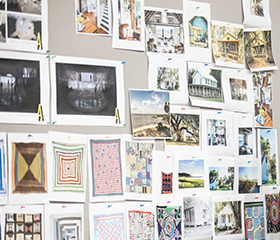It is wholly right and fitting that Adam Rigg work on a play called The Blood Quilt. Rigg, who did the set design for the Katori Hall play now previewing in the Newhouse, has clothing in their blood: they grew up in southern California where their mother worked in costume construction, and they themselves studied costume design at UCLA as an undergrad before switching to sets in graduate school at Yale.
And Rigg’s background makes this production appropriate for the other challenge of the play’s title: contending with quilts. “I did some quilting growing up, though I haven’t really quilted since my teens,” they told me. “Mostly, I embroider. I make my own pillows and curtains. I can lose hours in these pursuits. I like reading and watching TV but if I’m going to lose hours to something I’d rather have something to show for it in the end.”
There’s so much on show for The Blood Quilt that Rigg and Lileana Blain-Cruz, the evening’s director, found themselves in tech rehearsal pulling back on original conceptions. “There are so many quilts to look at,” Rigg said, “that we’ve been drawn to simplifying things that touch the set itself, as well as using more solid patterns.”
Simplification is not activity stereotypically associated with Blain-Cruz or Rigg. They met at Yale and joke that the director only calls upon the designer for something un-minimalist. “People call us ‘maximalist,’” Rigg said. “I call it doing the show.” For the 2022 production of Thornton Wilder’s The Skin of Our Teeth, which marked Rigg’s LCT debut, and for which they received a Tony nomination, the designer said that everything up on the color-crammed stage of the Beaumont related to Wilder’s text. “I went to UCLA, and I teach there now. It’s a research university. There’s a big emphasis on theater history. I tell my students to grapple with the text. I also tell them that the playwright and director present us with challenges, and it’s our job to solve them.”
For The Blood Quilt, a primary challenge was using furniture that would be appropriate to the humid, ocean-adjacent conditions of the play’s coastal-Georgia setting. “This is the kind of furniture where its upholstery must be replaceable because of the moisture-level,” Rigg said. The furniture is brown, they went on, because “brown is not a color that is used much in quilting so we’re not competing with the quilts.” Except for a sofa, the furniture itself was sourced from LCT’s prop storage. “One of the nice things about working at Lincoln Center Theater,” Rigg said, “is how much is right here. You find evidence of your previous work everywhere.”
Outfitting The Blood Quilt, Rigg said, has proven more challenging than initially expected. “The props ask of this show is insane,” they said. “On the page, the play reads as this really interesting but simple family drama. But when you look at the daily rehearsal reports the show keeps getting more and more complicated. We couldn’t be minimalist if we tried.”
Brendan Lemon is a freelance journalist in New York.
